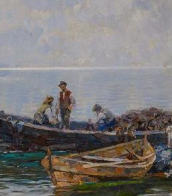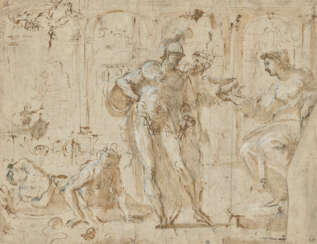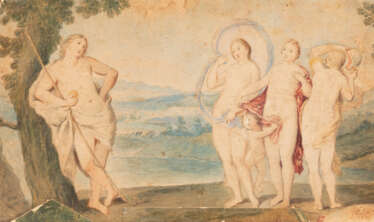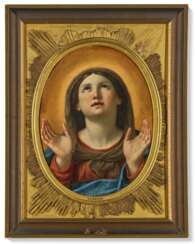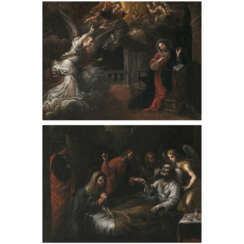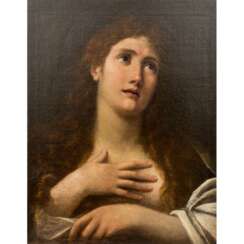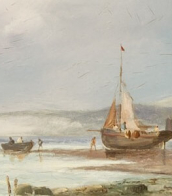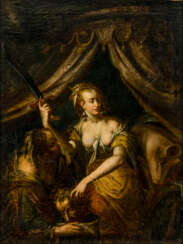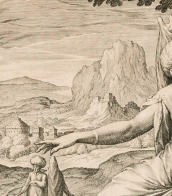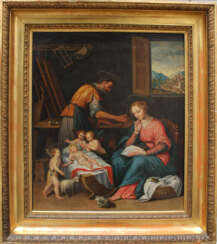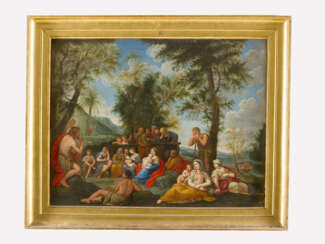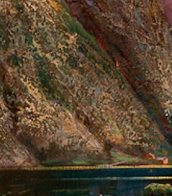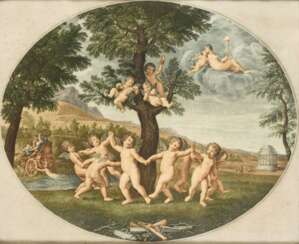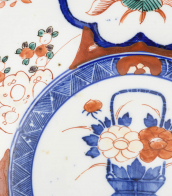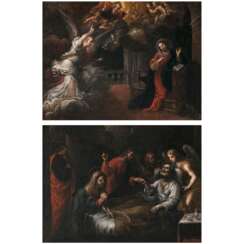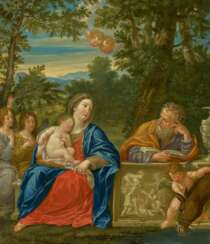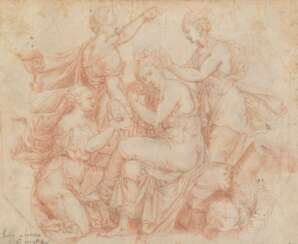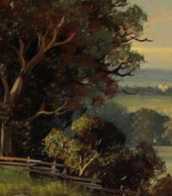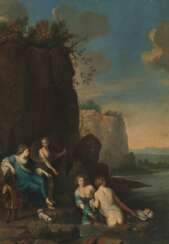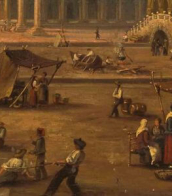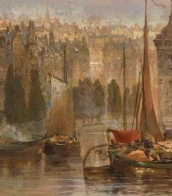francesco albani (1578 - 1660)
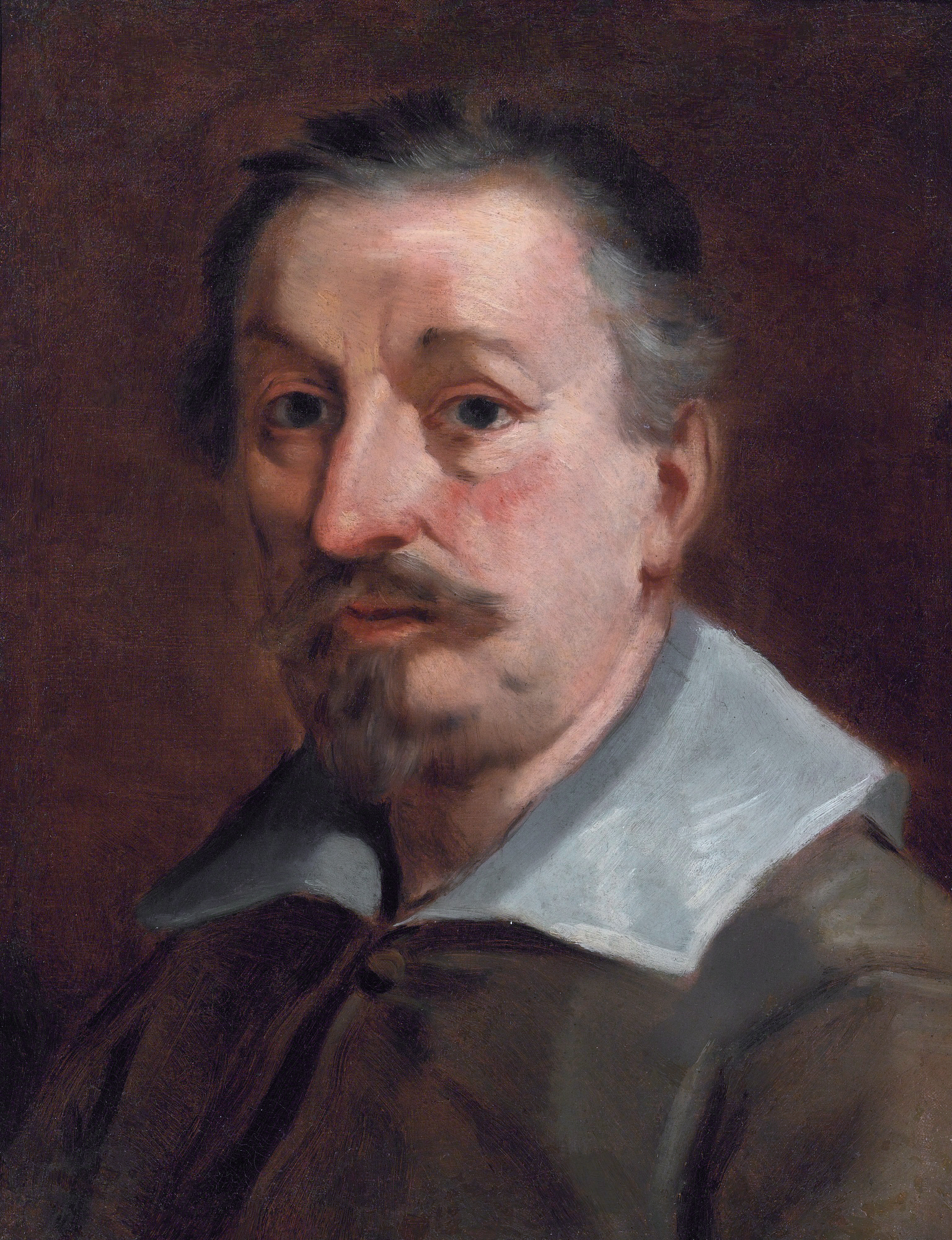
Francesco Albani was a renowned Italian painter and fresco artist. He is celebrated for his contributions to the academic Bolognese school, which was profoundly influenced by the Carracci family, under whom Albani trained. Albani's artistic journey began at the young age of 12, marking the start of a career that would see him become one of the 17th-century's most esteemed Bolognese masters.
Francesco Albani's style is characterized by its lyricism and often features cherubic figures, a trait that became his signature. Despite not embracing the monumentality or tenebrism prevalent in the works of his contemporaries, his thematic appeal and mannerist elegance have earned him a place in art history. His works often comprise mythological and religious scenes, executed with a refined and lyrical view of nature. This approach helped disseminate the classical ideals prominent in Carracci's landscapes.
Among Francesco Albani's notable works are his frescoes in the Hall of Aeneas at Palazzo Fava in Bologna and Palazzo Doria Pamphilj in Rome, and his paintings "The Judgment of Paris" and "The Toilet of Venus". His works can be found in prestigious collections worldwide, including the Museo del Prado, Galleria Borghese in Rome, and the Hermitage in St. Petersburg.
Francesco Albani's influence extended beyond his lifetime, with his classicising and idealised scenes finding favor with 18th-century French painters and collectors. However, his popularity waned during the 19th century. Despite this, his work remains an integral part of the study of Baroque art, particularly in understanding the transition from Mannerism to Baroque styles.
For collectors and experts in art and antiques, the legacy of Francesco Albani presents an opportunity to explore a pivotal moment in the history of Italian painting. His works not only provide aesthetic pleasure but also serve as important cultural artifacts, offering insights into the artistic trends and societal values of the 17th century.
If you are passionate about art history and wish to stay informed about new discoveries, sales, and auction events related to Francesco Albani, consider signing up for updates. This subscription will ensure you remain at the forefront of developments in the world of art and antiques, especially concerning this remarkable Italian master.


Francesco Albani was a renowned Italian painter and fresco artist. He is celebrated for his contributions to the academic Bolognese school, which was profoundly influenced by the Carracci family, under whom Albani trained. Albani's artistic journey began at the young age of 12, marking the start of a career that would see him become one of the 17th-century's most esteemed Bolognese masters.
Francesco Albani's style is characterized by its lyricism and often features cherubic figures, a trait that became his signature. Despite not embracing the monumentality or tenebrism prevalent in the works of his contemporaries, his thematic appeal and mannerist elegance have earned him a place in art history. His works often comprise mythological and religious scenes, executed with a refined and lyrical view of nature. This approach helped disseminate the classical ideals prominent in Carracci's landscapes.
Among Francesco Albani's notable works are his frescoes in the Hall of Aeneas at Palazzo Fava in Bologna and Palazzo Doria Pamphilj in Rome, and his paintings "The Judgment of Paris" and "The Toilet of Venus". His works can be found in prestigious collections worldwide, including the Museo del Prado, Galleria Borghese in Rome, and the Hermitage in St. Petersburg.
Francesco Albani's influence extended beyond his lifetime, with his classicising and idealised scenes finding favor with 18th-century French painters and collectors. However, his popularity waned during the 19th century. Despite this, his work remains an integral part of the study of Baroque art, particularly in understanding the transition from Mannerism to Baroque styles.
For collectors and experts in art and antiques, the legacy of Francesco Albani presents an opportunity to explore a pivotal moment in the history of Italian painting. His works not only provide aesthetic pleasure but also serve as important cultural artifacts, offering insights into the artistic trends and societal values of the 17th century.
If you are passionate about art history and wish to stay informed about new discoveries, sales, and auction events related to Francesco Albani, consider signing up for updates. This subscription will ensure you remain at the forefront of developments in the world of art and antiques, especially concerning this remarkable Italian master.


Francesco Albani was a renowned Italian painter and fresco artist. He is celebrated for his contributions to the academic Bolognese school, which was profoundly influenced by the Carracci family, under whom Albani trained. Albani's artistic journey began at the young age of 12, marking the start of a career that would see him become one of the 17th-century's most esteemed Bolognese masters.
Francesco Albani's style is characterized by its lyricism and often features cherubic figures, a trait that became his signature. Despite not embracing the monumentality or tenebrism prevalent in the works of his contemporaries, his thematic appeal and mannerist elegance have earned him a place in art history. His works often comprise mythological and religious scenes, executed with a refined and lyrical view of nature. This approach helped disseminate the classical ideals prominent in Carracci's landscapes.
Among Francesco Albani's notable works are his frescoes in the Hall of Aeneas at Palazzo Fava in Bologna and Palazzo Doria Pamphilj in Rome, and his paintings "The Judgment of Paris" and "The Toilet of Venus". His works can be found in prestigious collections worldwide, including the Museo del Prado, Galleria Borghese in Rome, and the Hermitage in St. Petersburg.
Francesco Albani's influence extended beyond his lifetime, with his classicising and idealised scenes finding favor with 18th-century French painters and collectors. However, his popularity waned during the 19th century. Despite this, his work remains an integral part of the study of Baroque art, particularly in understanding the transition from Mannerism to Baroque styles.
For collectors and experts in art and antiques, the legacy of Francesco Albani presents an opportunity to explore a pivotal moment in the history of Italian painting. His works not only provide aesthetic pleasure but also serve as important cultural artifacts, offering insights into the artistic trends and societal values of the 17th century.
If you are passionate about art history and wish to stay informed about new discoveries, sales, and auction events related to Francesco Albani, consider signing up for updates. This subscription will ensure you remain at the forefront of developments in the world of art and antiques, especially concerning this remarkable Italian master.
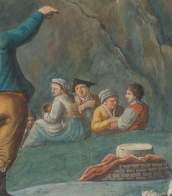

Francesco Albani was a renowned Italian painter and fresco artist. He is celebrated for his contributions to the academic Bolognese school, which was profoundly influenced by the Carracci family, under whom Albani trained. Albani's artistic journey began at the young age of 12, marking the start of a career that would see him become one of the 17th-century's most esteemed Bolognese masters.
Francesco Albani's style is characterized by its lyricism and often features cherubic figures, a trait that became his signature. Despite not embracing the monumentality or tenebrism prevalent in the works of his contemporaries, his thematic appeal and mannerist elegance have earned him a place in art history. His works often comprise mythological and religious scenes, executed with a refined and lyrical view of nature. This approach helped disseminate the classical ideals prominent in Carracci's landscapes.
Among Francesco Albani's notable works are his frescoes in the Hall of Aeneas at Palazzo Fava in Bologna and Palazzo Doria Pamphilj in Rome, and his paintings "The Judgment of Paris" and "The Toilet of Venus". His works can be found in prestigious collections worldwide, including the Museo del Prado, Galleria Borghese in Rome, and the Hermitage in St. Petersburg.
Francesco Albani's influence extended beyond his lifetime, with his classicising and idealised scenes finding favor with 18th-century French painters and collectors. However, his popularity waned during the 19th century. Despite this, his work remains an integral part of the study of Baroque art, particularly in understanding the transition from Mannerism to Baroque styles.
For collectors and experts in art and antiques, the legacy of Francesco Albani presents an opportunity to explore a pivotal moment in the history of Italian painting. His works not only provide aesthetic pleasure but also serve as important cultural artifacts, offering insights into the artistic trends and societal values of the 17th century.
If you are passionate about art history and wish to stay informed about new discoveries, sales, and auction events related to Francesco Albani, consider signing up for updates. This subscription will ensure you remain at the forefront of developments in the world of art and antiques, especially concerning this remarkable Italian master.


Francesco Albani was a renowned Italian painter and fresco artist. He is celebrated for his contributions to the academic Bolognese school, which was profoundly influenced by the Carracci family, under whom Albani trained. Albani's artistic journey began at the young age of 12, marking the start of a career that would see him become one of the 17th-century's most esteemed Bolognese masters.
Francesco Albani's style is characterized by its lyricism and often features cherubic figures, a trait that became his signature. Despite not embracing the monumentality or tenebrism prevalent in the works of his contemporaries, his thematic appeal and mannerist elegance have earned him a place in art history. His works often comprise mythological and religious scenes, executed with a refined and lyrical view of nature. This approach helped disseminate the classical ideals prominent in Carracci's landscapes.
Among Francesco Albani's notable works are his frescoes in the Hall of Aeneas at Palazzo Fava in Bologna and Palazzo Doria Pamphilj in Rome, and his paintings "The Judgment of Paris" and "The Toilet of Venus". His works can be found in prestigious collections worldwide, including the Museo del Prado, Galleria Borghese in Rome, and the Hermitage in St. Petersburg.
Francesco Albani's influence extended beyond his lifetime, with his classicising and idealised scenes finding favor with 18th-century French painters and collectors. However, his popularity waned during the 19th century. Despite this, his work remains an integral part of the study of Baroque art, particularly in understanding the transition from Mannerism to Baroque styles.
For collectors and experts in art and antiques, the legacy of Francesco Albani presents an opportunity to explore a pivotal moment in the history of Italian painting. His works not only provide aesthetic pleasure but also serve as important cultural artifacts, offering insights into the artistic trends and societal values of the 17th century.
If you are passionate about art history and wish to stay informed about new discoveries, sales, and auction events related to Francesco Albani, consider signing up for updates. This subscription will ensure you remain at the forefront of developments in the world of art and antiques, especially concerning this remarkable Italian master.
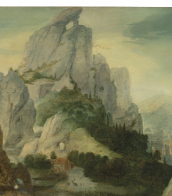

Francesco Albani was a renowned Italian painter and fresco artist. He is celebrated for his contributions to the academic Bolognese school, which was profoundly influenced by the Carracci family, under whom Albani trained. Albani's artistic journey began at the young age of 12, marking the start of a career that would see him become one of the 17th-century's most esteemed Bolognese masters.
Francesco Albani's style is characterized by its lyricism and often features cherubic figures, a trait that became his signature. Despite not embracing the monumentality or tenebrism prevalent in the works of his contemporaries, his thematic appeal and mannerist elegance have earned him a place in art history. His works often comprise mythological and religious scenes, executed with a refined and lyrical view of nature. This approach helped disseminate the classical ideals prominent in Carracci's landscapes.
Among Francesco Albani's notable works are his frescoes in the Hall of Aeneas at Palazzo Fava in Bologna and Palazzo Doria Pamphilj in Rome, and his paintings "The Judgment of Paris" and "The Toilet of Venus". His works can be found in prestigious collections worldwide, including the Museo del Prado, Galleria Borghese in Rome, and the Hermitage in St. Petersburg.
Francesco Albani's influence extended beyond his lifetime, with his classicising and idealised scenes finding favor with 18th-century French painters and collectors. However, his popularity waned during the 19th century. Despite this, his work remains an integral part of the study of Baroque art, particularly in understanding the transition from Mannerism to Baroque styles.
For collectors and experts in art and antiques, the legacy of Francesco Albani presents an opportunity to explore a pivotal moment in the history of Italian painting. His works not only provide aesthetic pleasure but also serve as important cultural artifacts, offering insights into the artistic trends and societal values of the 17th century.
If you are passionate about art history and wish to stay informed about new discoveries, sales, and auction events related to Francesco Albani, consider signing up for updates. This subscription will ensure you remain at the forefront of developments in the world of art and antiques, especially concerning this remarkable Italian master.
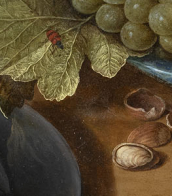

Francesco Albani was a renowned Italian painter and fresco artist. He is celebrated for his contributions to the academic Bolognese school, which was profoundly influenced by the Carracci family, under whom Albani trained. Albani's artistic journey began at the young age of 12, marking the start of a career that would see him become one of the 17th-century's most esteemed Bolognese masters.
Francesco Albani's style is characterized by its lyricism and often features cherubic figures, a trait that became his signature. Despite not embracing the monumentality or tenebrism prevalent in the works of his contemporaries, his thematic appeal and mannerist elegance have earned him a place in art history. His works often comprise mythological and religious scenes, executed with a refined and lyrical view of nature. This approach helped disseminate the classical ideals prominent in Carracci's landscapes.
Among Francesco Albani's notable works are his frescoes in the Hall of Aeneas at Palazzo Fava in Bologna and Palazzo Doria Pamphilj in Rome, and his paintings "The Judgment of Paris" and "The Toilet of Venus". His works can be found in prestigious collections worldwide, including the Museo del Prado, Galleria Borghese in Rome, and the Hermitage in St. Petersburg.
Francesco Albani's influence extended beyond his lifetime, with his classicising and idealised scenes finding favor with 18th-century French painters and collectors. However, his popularity waned during the 19th century. Despite this, his work remains an integral part of the study of Baroque art, particularly in understanding the transition from Mannerism to Baroque styles.
For collectors and experts in art and antiques, the legacy of Francesco Albani presents an opportunity to explore a pivotal moment in the history of Italian painting. His works not only provide aesthetic pleasure but also serve as important cultural artifacts, offering insights into the artistic trends and societal values of the 17th century.
If you are passionate about art history and wish to stay informed about new discoveries, sales, and auction events related to Francesco Albani, consider signing up for updates. This subscription will ensure you remain at the forefront of developments in the world of art and antiques, especially concerning this remarkable Italian master.
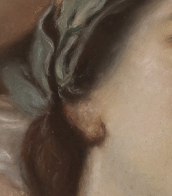

Francesco Albani was a renowned Italian painter and fresco artist. He is celebrated for his contributions to the academic Bolognese school, which was profoundly influenced by the Carracci family, under whom Albani trained. Albani's artistic journey began at the young age of 12, marking the start of a career that would see him become one of the 17th-century's most esteemed Bolognese masters.
Francesco Albani's style is characterized by its lyricism and often features cherubic figures, a trait that became his signature. Despite not embracing the monumentality or tenebrism prevalent in the works of his contemporaries, his thematic appeal and mannerist elegance have earned him a place in art history. His works often comprise mythological and religious scenes, executed with a refined and lyrical view of nature. This approach helped disseminate the classical ideals prominent in Carracci's landscapes.
Among Francesco Albani's notable works are his frescoes in the Hall of Aeneas at Palazzo Fava in Bologna and Palazzo Doria Pamphilj in Rome, and his paintings "The Judgment of Paris" and "The Toilet of Venus". His works can be found in prestigious collections worldwide, including the Museo del Prado, Galleria Borghese in Rome, and the Hermitage in St. Petersburg.
Francesco Albani's influence extended beyond his lifetime, with his classicising and idealised scenes finding favor with 18th-century French painters and collectors. However, his popularity waned during the 19th century. Despite this, his work remains an integral part of the study of Baroque art, particularly in understanding the transition from Mannerism to Baroque styles.
For collectors and experts in art and antiques, the legacy of Francesco Albani presents an opportunity to explore a pivotal moment in the history of Italian painting. His works not only provide aesthetic pleasure but also serve as important cultural artifacts, offering insights into the artistic trends and societal values of the 17th century.
If you are passionate about art history and wish to stay informed about new discoveries, sales, and auction events related to Francesco Albani, consider signing up for updates. This subscription will ensure you remain at the forefront of developments in the world of art and antiques, especially concerning this remarkable Italian master.

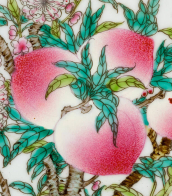
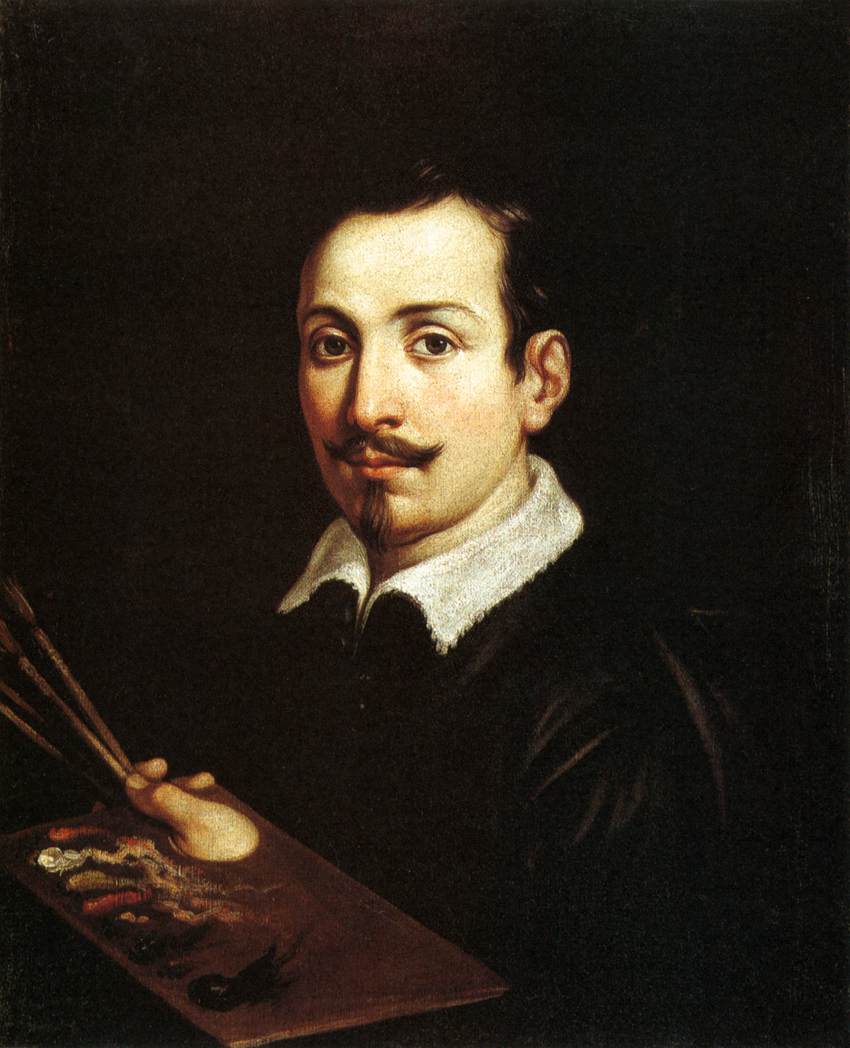
Guido Reni was an Italian Baroque painter, celebrated for his refined and classical approach to art. Born in Bologna, Italy, Reni's career spanned the late Renaissance and early Baroque periods, where he became known for his religious and mythological scenes. His style, characterized by elegance and grace, set him apart from his contemporaries, making his works highly sought after by both religious and secular patrons.
Reni's training under Denys Calvaert, followed by his time in the Carracci workshop, laid the foundation for his distinctive blend of classical idealism and Baroque dynamism. This education, coupled with his interactions and reported rivalry with Caravaggio in Rome, influenced his development as an artist who could balance the dramatic intensity of the Baroque with a serene classicism.
One of Reni's most famous works, the fresco "Aurora" in the Casino dell'Aurora of Palazzo Pallavicini-Rospigliosi, showcases his mastery of classical forms and his ability to convey narrative through expressive composition and vibrant color. This masterpiece, depicting Apollo's chariot led by Dawn, is celebrated for its simplicity and restraint, contrasting the more elaborate compositions typical of his era.
Reni's contributions to religious art are also significant, with works such as "The Archangel Michael Defeating Satan" and "Saint Joseph and the Christ Child" reflecting his capacity to imbue traditional Christian subjects with a profound sense of divinity and humanity. His paintings are distinguished by their delicate treatment of light and shadow, a hallmark of his refined aesthetic.
Collectors and art experts continue to admire Reni's works for their technical brilliance and emotional depth. His paintings, such as "The Massacre of the Innocents" and "Saint Sebastian," are preserved in major museums worldwide, testament to his enduring influence on Western art. Reni's legacy as a bridge between the Renaissance's ideal beauty and the Baroque's emotive power remains unparalleled, securing his place among the pantheon of great artists.
For collectors and experts in the field of art and antiques, Guido Reni's oeuvre represents not just the pinnacle of Baroque painting but also a connection to the cultural and aesthetic shifts of his time. To stay updated on sales, auctions, and exhibitions related to Guido Reni's works, signing up for updates can provide exclusive insights and opportunities to engage with the legacy of this exceptional artist.



Francesco Albani was a renowned Italian painter and fresco artist. He is celebrated for his contributions to the academic Bolognese school, which was profoundly influenced by the Carracci family, under whom Albani trained. Albani's artistic journey began at the young age of 12, marking the start of a career that would see him become one of the 17th-century's most esteemed Bolognese masters.
Francesco Albani's style is characterized by its lyricism and often features cherubic figures, a trait that became his signature. Despite not embracing the monumentality or tenebrism prevalent in the works of his contemporaries, his thematic appeal and mannerist elegance have earned him a place in art history. His works often comprise mythological and religious scenes, executed with a refined and lyrical view of nature. This approach helped disseminate the classical ideals prominent in Carracci's landscapes.
Among Francesco Albani's notable works are his frescoes in the Hall of Aeneas at Palazzo Fava in Bologna and Palazzo Doria Pamphilj in Rome, and his paintings "The Judgment of Paris" and "The Toilet of Venus". His works can be found in prestigious collections worldwide, including the Museo del Prado, Galleria Borghese in Rome, and the Hermitage in St. Petersburg.
Francesco Albani's influence extended beyond his lifetime, with his classicising and idealised scenes finding favor with 18th-century French painters and collectors. However, his popularity waned during the 19th century. Despite this, his work remains an integral part of the study of Baroque art, particularly in understanding the transition from Mannerism to Baroque styles.
For collectors and experts in art and antiques, the legacy of Francesco Albani presents an opportunity to explore a pivotal moment in the history of Italian painting. His works not only provide aesthetic pleasure but also serve as important cultural artifacts, offering insights into the artistic trends and societal values of the 17th century.
If you are passionate about art history and wish to stay informed about new discoveries, sales, and auction events related to Francesco Albani, consider signing up for updates. This subscription will ensure you remain at the forefront of developments in the world of art and antiques, especially concerning this remarkable Italian master.
